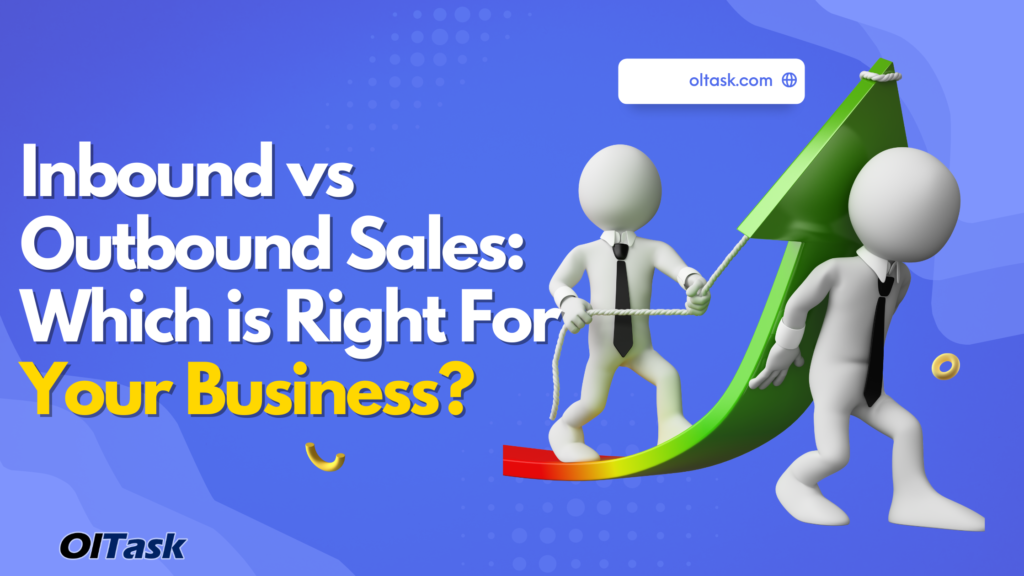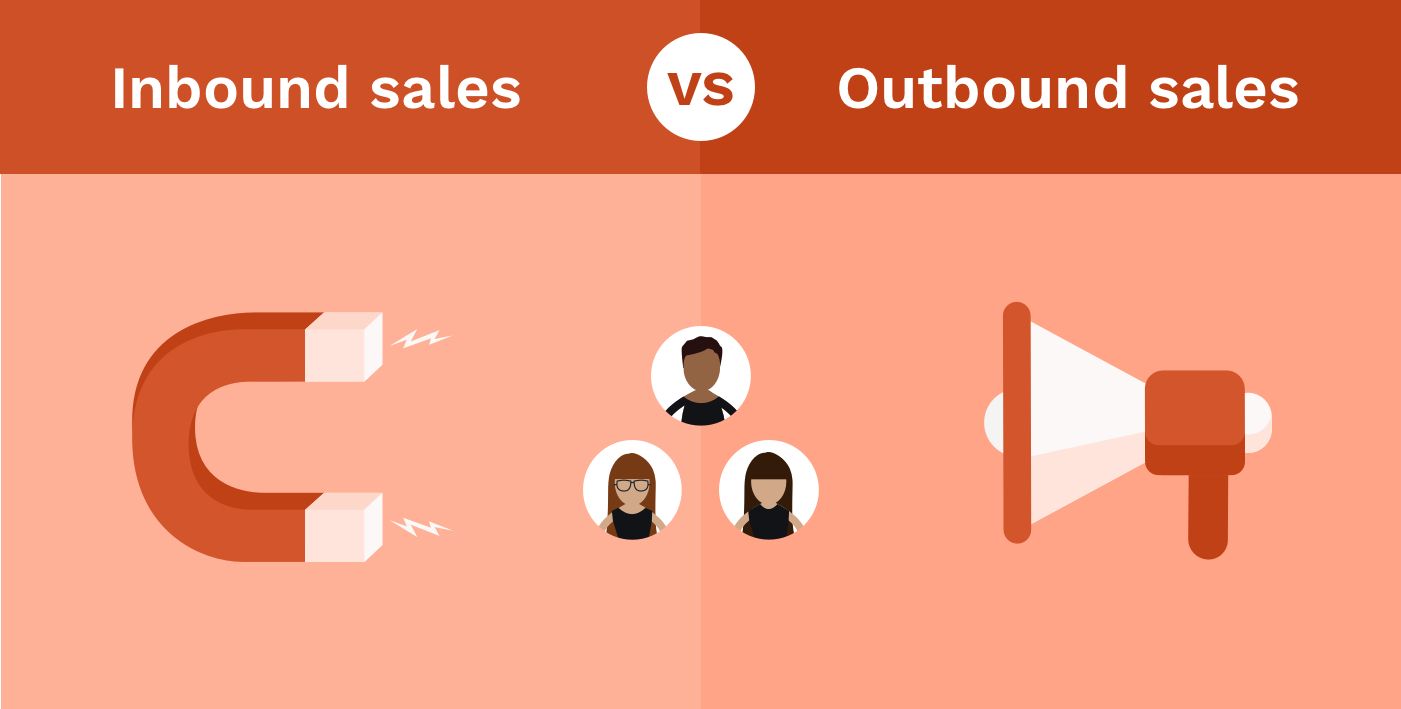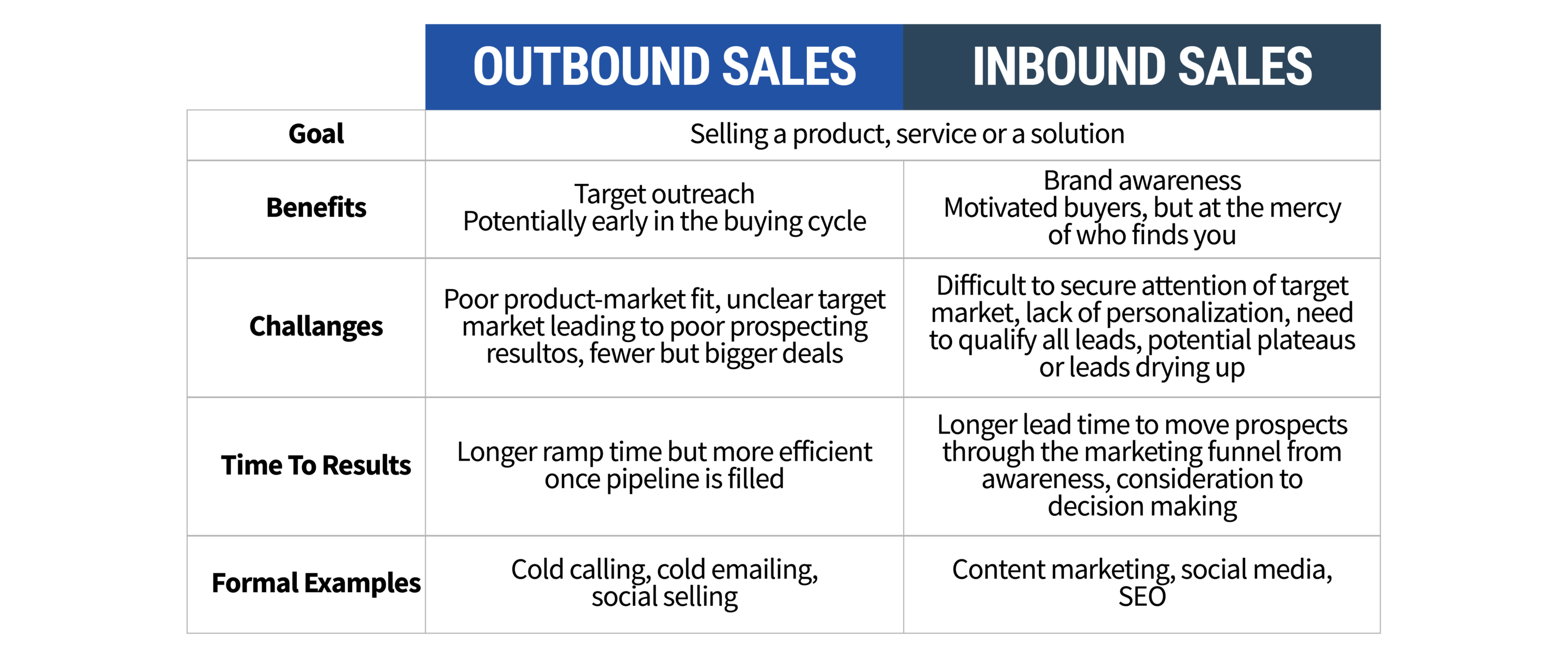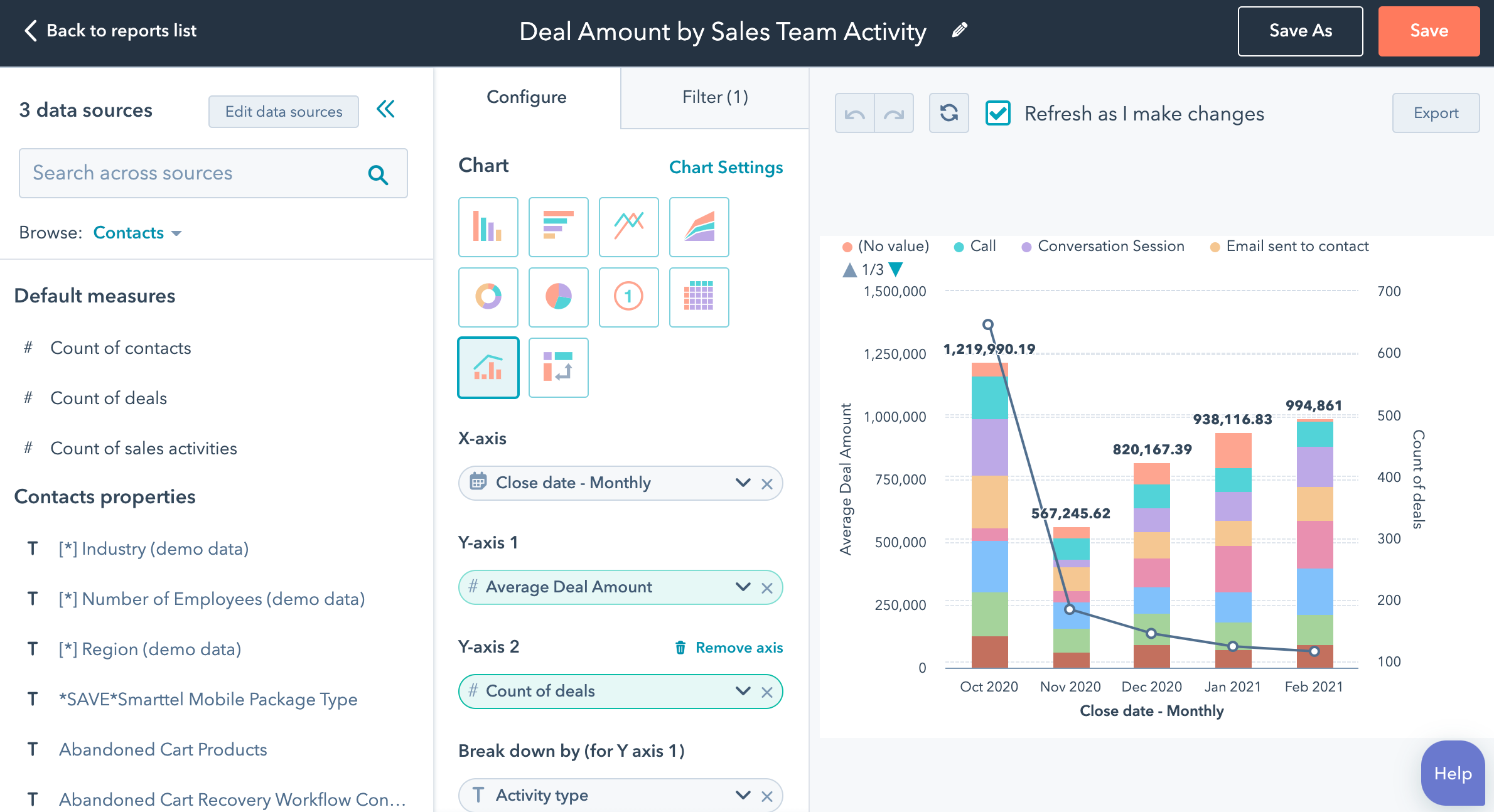Inbound vs. Outbound Sales: A Comprehensive Comparison

Hey there, savvy business enthusiasts! Ready to demystify the dynamic world of sales methodologies and navigate the path to sales success? If you’ve ever pondered the age-old question of inbound vs. outbound sales, you’re in for a treat. In this guide, we’re diving deep into the intricacies of these two approaches to help you steer your business toward victory. So, buckle up, and let’s embark on this enlightening journey!
When it comes to sales, the terrain can be complex, and choosing the right strategy is paramount. In the bustling realm of business, two dominant methodologies take center stage: inbound and outbound sales. These methodologies are not just buzzwords; they are distinct approaches that can significantly impact your sales endeavors.
Understanding Inbound Sales

Imagine a sales approach where customers come knocking on your door, eagerly seeking your solutions. That’s the essence of inbound sales.
This customer-centric methodology revolves around attracting potential clients through valuable content and solutions, transforming them into loyal patrons. It’s all about building connections and offering tailored solutions that address customers’ unique pain points and goals.
Key Strategies and Techniques

Inbound sales is a powerhouse of value creation. Instead of force-feeding sales pitches, it embraces a customer-centric approach.
- Educational Content – Inbound sales harnesses the power of informative content such as blog posts, videos, and ebooks. These resources cater to customers’ pain points, providing solutions and insights.
- Lead Nurturing – Instead of pursuing immediate conversions, inbound sales focuses on nurturing leads over time. By offering valuable content at each stage of the buyer’s journey, businesses build rapport and trust.
- Personalization – Inbound sales employs data-driven personalization. Content is tailored to individual preferences, enhancing the customer experience and demonstrating a deep understanding of their needs.
- Engagement across Channels – Businesses engage with potential customers across multiple channels, from social media to email campaigns. This omni-channel approach keeps the brand visible and accessible.
- Solving Pain Points – Inbound sales identifies customers’ pain points and offers solutions. This problem-solving approach creates a sense of partnership and positions the business as an industry authority.
Through these strategies, inbound sales nurtures prospects, fosters relationships, and establishes a reputation for excellence.
Benefits of Inbound Sales

Inbound sales isn’t just a strategy; it’s a trust-building marvel with significant advantages.
- Building Unshakable Trust – Inbound sales begins with a handshake of value. By dishing out insights and solutions, businesses win trust that later transforms into a solid bedrock of credibility. This credibility fuels conversions like never before.
- Spotlight on Brand – Content isn’t just content; it’s a spotlight that shines on brands. Through engaging content marketing and active social media participation, businesses amplify brand visibility, captivating a wider audience and engraving brand recognition.
- Seeding Long-Lasting Relationships – Think of inbound sales as the matchmaker of business relationships. Its nurturing approach blooms leads into loyal customers. These strong, lasting bonds extend beyond transactions, creating a community of advocates.
- Tailored Solutions – Inbound sales doesn’t believe in one-size-fits-all. It crafts content that speaks directly to customers’ unique pain points, resonating with them on a personal level.
- Unwavering Support – The journey doesn’t end at the checkout. Inbound sales extends a helping hand, providing support when customers need it most, transforming buyers into brand enthusiasts.
- Continuous Communication – A relationship thrives on communication. Inbound sales keeps the dialogue alive with engaging follow-ups, valuable insights, and updates that resonate with customers’ evolving needs.
- Value-driven Magnet – Valuable content pulls customers in, slashing the need for pricey outbound marketing campaigns.
- Streamlined Automation – Tools make the journey smooth. Automation lends a helping hand, scaling the process without adding extra pressure.
- Efficiency Amplified – With inbound sales, businesses do more with less. Valuable content and automation create a cost-effective, scalable strategy that transforms leads into loyal customers.
Inbound sales isn’t just a strategy; it’s a journey of trust, brand growth, and enduring relationships. With personalized solutions, unwavering support, and streamlined efficiency, businesses unlock the true potential of inbound sales, turning prospects into dedicated brand enthusiasts.
Challenges and Potential Drawbacks
Inbound sales indeed holds a bouquet of benefits, but it’s essential to acknowledge its challenges and thorns along the way. Here’s a glimpse into the hurdles that businesses might encounter when embracing this strategy.
- Time-Intensive Conversion – The nurturing process takes time. Converting leads into loyal customers is a marathon, not a sprint, demanding patience and persistence.
- Longer Sales Cycle – Building relationships and trust doesn’t happen overnight. The sales cycle might be longer, requiring sustained effort to close deals.
- Potential Unpredictability – Relying on customers’ own initiative means that results can be less predictable. Not all leads will progress, making consistent conversion rates a challenge.
- Content Quality Demand – Generating valuable content consistently requires effort. Maintaining a high level of content quality to attract and engage leads can be demanding.
Despite these challenges, the rewards of inbound vs outbound sales are well worth the journey.
Deciphering Outbound Sales

Now, let’s switch gears to outbound sales, a proactive approach where salespeople take the lead. Instead of waiting for customers to come to them, they actively reach out. This method involves initiating contact through techniques like cold calling, email marketing, and direct mail.
Primary Strategies and Approaches
Outbound sales unfolds a dynamic array of strategies, each designed to seize the spotlight and captivate prospects. These tactics are the guiding stars that steer your ship through the vast ocean of opportunities:
- Cold Calling – The classic method of reaching out to potential customers via phone calls, delivering your pitch directly to their ears.
- Email Marketing – Crafting personalized emails that land right in your prospects’ inboxes, delivering tailored messages and offers.
- Direct Mail – Going old-school with physical mail, sending brochures, flyers, or promotional materials to stand out amidst digital noise.
- Networking Events & Trade Shows – Stepping into the real world, these events offer face-to-face interactions to forge connections and leave lasting impressions.
Each strategy serves as a unique instrument in the outbound symphony, harmonizing to create an impactful melody that resonates with potential customers.
Advantages of outbound sales

Outbound sales stands as a beacon of swift achievements, offering immediate rewards through direct interactions with prospects. These advantages shine bright, guiding your efforts toward success.
- Immediate Results – With outbound sales, results are not just around the corner; they’re here right now. Directly engaging with prospects ensures quick responses and prompt conversions, turning potential into tangible outcomes.
- Reaching Passive Prospects – Not all treasure hunters are active seekers. Outbound sales casts its net wide, capturing the attention of individuals who might not be actively scouring the market. It introduces them to solutions they didn’t even realize they were missing, expanding your reach beyond the usual suspects.
- Instant Spark – Outbound sales ignites immediate responses. Retargeting ads, with their captivating visuals and personalized messaging, turn heads in an instant, prompting engagement and action.
- Real-time Feedback – It’s not a waiting game. Outbound sales techniques deliver quick reactions and feedback, allowing you to gauge the effectiveness of your strategies and make rapid adjustments to keep your efforts sailing smoothly.
- Broader Reach – Outbound sales casts a wider net, capturing the attention of potential customers who might not have actively sought your solutions. This expanded scope means you can tap into a pool of prospects that other strategies might overlook.
- Avenues of Discovery – By proactively reaching out to passive prospects, you’re like an adventurer stumbling upon hidden treasures. Your outreach introduces them to offerings they hadn’t considered, sparking curiosity and paving the way for new leads and conversions.
In the realm of sales, outbound strategies are like a compass guiding you to immediate outcomes. Engaging with prospects directly, these techniques bring quick results, expand your reach, and uncover hidden opportunities.
Common hurdles and potential pitfall
Outbound sales comes with its share of hurdles that you need to steer through. Be prepared to face resistance from prospects who might not be receptive to unsolicited outreach.
- Resistance from Prospects – Some may not welcome unsolicited pitches, and objections can be encountered.
- Intrusiveness Perception – Outbound sales might be seen as intrusive, potentially tarnishing your brand’s image.
- Scaling Demands – Effective outbound sales calls for dedicated teams and strategic scaling plans, requiring careful resources allocation.
Navigating these waters requires finesse and adaptability, but with the right approach, these challenges can be turned into opportunities for growth and refinement.
Comparing Inbound and Outbound Sales

Now that we’ve dived into the depths of both inbound vs outbound sales, it’s time for a friendly face-off. In the left corner, we have inbound sales – the relationship builder. In the right corner, outbound sales – the proactive pursuer. Let’s see how they stack up.
Approach to leads and customers
When it comes to leads and customers, two distinct paths unfold: one waits, the other reaches out. Here’s the lowdown on their approaches.
Inbound Sales: Customers Come to You
- Builds trust by offering valuable content and solutions.
- Attracts interested prospects seeking solutions organically.
Outbound Sales: Proactive Engagement
- Engages through proactive methods like cold calling and outreach.
- Initiates direct contact to generate interest and prompt action.
Efficiency and cost implications
Efficiency and cost implications steer the ship in different directions.
Inbound Sales: Cost-Effective Strategy
- Draws leads with valuable content, slashing reliance on costly outbound campaigns.
- Leverages automation tools for streamlined and scalable processes.
Outbound Sales: Immediate Impact, Resource Demand
- Yields quick results but requires resources for proactive outreach.
- Scaling demands dedicated teams and careful resource allocation.
Short-term vs. long-term results
The battle between short-term and long-term results unfolds.
Outbound Sales: Swift Gains
- Generates quick responses and immediate outcomes.
- Effective for fast-paced sales needs.
Inbound Sales: Relationship Building
- Establishes trust and loyalty for enduring customer relationships.
- Prioritizes individual needs and nurtures long-lasting partnerships.
Integration in modern business models
A symbiotic relationship between inbound and outbound strategies emerges.
- Inbound Attraction – Draws in interested leads through valuable content and personalized engagement.
- Outbound Expansion – Reaches broader audiences, creating immediate impact and expanding reach.
- Holistic Strategy – Seamlessly integrates both methods for a comprehensive sales approach.
- Adaptable Dynamics – Evolves with changing market demands, optimizing results and customer connections.
Inbound vs Outbound Sales in Action: Real-world Examples
Time to meet the stars of the show – HubSpot and Salesforce, the dynamic duo of sales mastery. They’ve cracked the code of inbound vs outbound sales, and their stories are here to inspire.
Case Study: A Company Excelling in Inbound Sales

Let’s spotlight HubSpot, a trailblazer in inbound marketing and sales. By offering valuable content and personalized solutions, HubSpot has built a loyal audience.
- Value-Centric Branding – HubSpot’s authoritative stance in the inbound arena stems from its commitment to offering value. Through informative content, free resources, and thought leadership, HubSpot became a trusted source.
- Nurturing Quality Leads – The brand’s strategy focuses on attracting qualified leads. Their reservoir of valuable content entices potential customers who are genuinely interested in their offerings.
- Personalized Engagement – HubSpot’s prowess in inbound vs outbound sales lies in personalized interactions. They utilize data to recommend relevant products, fostering a connection and showing genuine interest in their customers’ needs.
- Long-Term Relationship Building – By prioritizing relationship-building over transactional approaches, HubSpot crafts enduring connections. Their continuous support, education, and resources help customers succeed in their marketing and sales endeavors.
HubSpot’s journey exemplifies the significance of inbound sales in building trust, establishing relationships, and driving long-term success.
Salesforce: The Outbound Champion

Consider Salesforce, a leader in CRM or customer relationship management. Their proactive outreach demonstrates the impact of direct engagement.
- Strategic Cold Calling – Salesforce’s outbound success begins with cold calling. Their sales team proactively reaches out to potential customers, introducing them to the benefits of their CRM platform. This personalized approach initiates direct conversations.
- Retargeting with Precision – Salesforce utilizes retargeting ads to re-engage leads. Dynamic retargeting showcases the exact products or solutions visitors abandoned, reminding them of their initial interest.
- Networking and Events – Salesforce’s active participation in industry events and trade shows bolsters their outbound efforts. Face-to-face engagements offer opportunities to connect directly, building relationships on the spot.
- Personalization Matters – Salesforce’s outbound tactics are effective due to personalization. They tailor messages to the audience, addressing pain points and providing relevant solutions.
Salesforce’s mastery of outbound sales is evident through their strategic cold calling, retargeting precision, and personalized engagement. This case study illustrates the potency of reaching out directly to prospects for effective results.
Vital Takeaways
The success stories of HubSpot and Salesforce offer crucial insights.
- Trust vs. Quick Wins – HubSpot’s inbound approach prioritizes building trust through personalized content. On the other hand, Salesforce’s outbound prowess generates quick results. Both approaches demonstrate the significance of addressing customer needs.
- Balancing Act – Integrating inbound and outbound strategies can lead to remarkable outcomes. HubSpot’s relationship-building and Salesforce’s proactive engagement harmonize for a holistic sales strategy.
- Customer-Centricity Reigns – Both companies place customers at the center. They understand their pain points, communicate effectively, and offer solutions that resonate.
HubSpot and Salesforce serve as beacons of effective sales practices. While inbound and outbound methods vary, the shared focus on customer-centricity unites them. The key takeaway is understanding your audience and providing value, be it through nurturing relationships or engaging proactively.
How to Determine the Right Approach for Your Business

Navigating the sales landscape can be complex, but these insights will guide you toward the ideal approach for your business.
- Audience Preferences – Are your customers actively searching for solutions, or are they waiting to be discovered? Understanding their approach guides your outreach.
- Resource Evaluation – Take stock of your budget and manpower. Determine the capacity for sales and marketing efforts, aligning your approach with available resources.
- Product Fit – Assess whether your offering requires personalized consultation or can be presented through content and resources. Tailor your approach to match your product’s intricacies.
- Relationship Harmony – Inbound excels at nurturing bonds, while outbound captures swift wins. Blend both for a comprehensive approach that appeals to a diverse audience.
- Goal Alignment – Define your objectives – whether it’s building long-term connections or quick conversions. The mix depends on your priorities and what you aim to achieve.
- Resource Optimization – Consider your available budget and team capacity. Craft a hybrid strategy that optimizes your resources for maximum impact and scalability.
- Agile Mindset – Customer needs change, so be ready to pivot. Stay attentive to market shifts and be open to modifying your strategies accordingly.
- Experimentation Zone – Don’t shy away from trying new tactics. A/B test different approaches to see what resonates best with your audience.
- Tech Integration – Embrace evolving technologies. Automation tools and data analytics can refine your sales process and enhance customer experiences.
- Continuous Refinement – Regularly review and tweak your strategies. Learn from successes and failures to consistently improve your approach.
Craft your sales strategy like a master composer, harmonizing inbound’s relationship-building with outbound’s quick wins. Tune in to your audience, orchestrate resources, and adapt with the changing market.
The Balance of Inbound vs Outbound Sales: Crafting Your Strategy for Success

In the world of sales, two giants stand tall: inbound vs outbound sales strategies. These are more than mere words; they’re distinct pathways that can shape your sales journey. In the hustle of business, understanding these methods is crucial.
Inbound sales is about customers finding you, drawn by valuable solutions. It thrives on personalized content, trust-building, and enduring connections. On the flip side, outbound sales means you go after prospects. It’s fast, direct, and offers quick wins. While inbound builds relationships, outbound delivers prompt outcomes.
Both approaches have their rewards and challenges. Integrating them leads to a comprehensive strategy. Whether it’s nurturing relationships or seizing quick wins, a well-balanced approach can lead you to sales excellence. Take the first step towards success today by getting in touch with our all-start sales team.